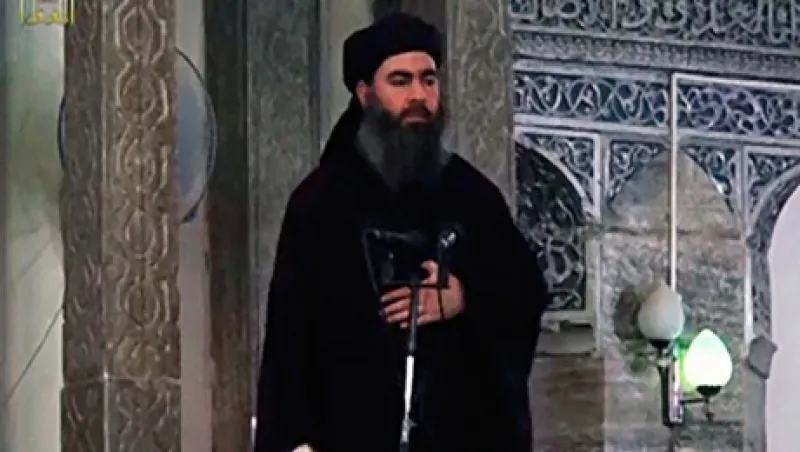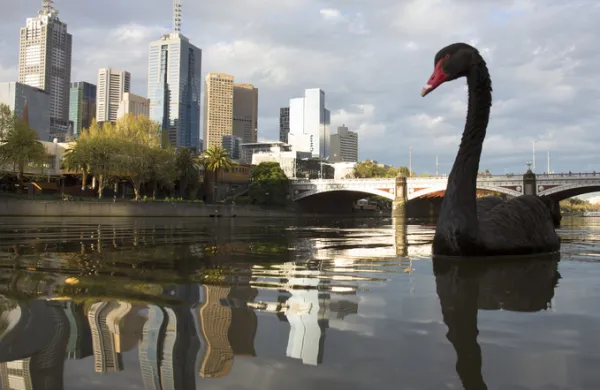“We are intensely anxious,” a senior UAE official tells me over a cup of hot, fragrant mint tea. “The Middle East is on fire,” he says, gesturing out across the turquoise waters of the Gulf to the north, “and yet the price of oil keeps falling.”
Worry beads are getting a workout around the shallow waters of the warm sea the Iranians call the Persian Gulf and the Arabs, of course, call the Arabian Gulf. There are 99 segments on the Arabic misbaha, normally used to count out the names of God. But these days the four big anxiety-inducing beads on the string are the ISIS, Iran, Barack Obama and Brent.
I should add that there are far fewer beads on the Greek variant of worry beads, known as a kombolói, which John Negroponte always carried around with him as ambassador to Iraq and then as director of National Intelligence (when he was my boss). “It’s a useful diplomatic device,” he told me once. “It gives me more time to think in a negotiation.” The number of segments on a kombolói is typically a prime number, usually 17, 19 or 23 — Go ponder that, all you quants.
Chaos in the Middle East’s arc of fire from Lebanon through Iraq is viewed by global macro traders as one variable in the multivariate regression whose dependent variable is the price of oil. The emirs, kings and princelings of the Gulf weigh that chaos as one variable in a shorter equation whose endpoint is their own survival. Their equation also assigns a large weight to the price of oil, their sole source (in addition to natural gas) of exports and revenue and the wellspring of funds with which to mollify their citizens and purchase security in a dangerous world. Brent crude has fallen 30 percent in a few months, hence the worries.
I spent a week kicking around the Gulf to get a better sense of how the world looks from there. It is a tough neighborhood, and the residents have good reason to be nervous. The geopolitical equation is indeed shifting on several fronts, not least the frighteningly rapid rise of ISIS in what used to be the countries of Syria and Iraq. And as Brent implodes, so does the fiscal position of all Gulf exchequers.
As for the first worry bead, “ISIS has now supplanted al-Qaeda in the U.S.’s demonology of extremist groups, but it has already occupied a similar position for a growing number of Middle Eastern states,” says Crispin Hawes, a Middle East analyst at Teneo Intelligence in London. “To Iran and its Hezbollah allies, ISIS is the bastard child of Western intervention and Wahhabi extremist anti-Shiism. To the Saudis, it is a revisitation by the Rule of Unintended Consequences, originally written during the 1980s Afghan war. To governments in Amman, Baghdad, Abu Dhabi and beyond, ISIS appears a very real and immediate threat.”
A year ago, when I made this same trek, my Arab friends were most worried about a Shia arc of influence from Iran across Iraq, through Bashar Assad’s Syria and down into territories controlled by Hezbollah and Hamas, whom they viewed as Tehran’s proxies. They saw Iranian machinations behind the restive Shia minorities along the west coast of the Gulf, and especially the Shia majority in Bahrain.
But now they are equally worried about radical Sunni Islam, not just Abu Bakr al-Baghdadi’s self-proclaimed caliphate under ISIS but also the embittered remnants of the Muslim Brotherhood, which have been driven underground in Egypt and across the region.
“The Qataris used to believe they could make a deal with the Muslim Brotherhood and that political engagement in Egypt — the responsibilities of actually managing the government of Egypt — would turn [former president Mohamed] Morsi and his colleagues into something like Erdogan and his AKP,” says a Continental diplomat with long experience in the region, referring to Turkish President Recep Tayyip Erdogan. “But that ambiguity is over. Now all the Gulf emirs and the House of Saud have thrown their lot in with military autocrats like [Egyptian President Abdel Fattah] al-Sisi. They are writing some very big checks to fund this. It’s a struggle to the finish with the Muslim Brotherhood. No more studied ambiguity or tous azimuts diplomacy. They are all exposed now.”
Some optimistic observers believe this mutual exposure may be enough to drive fractious Gulf monarchs, Turkish politicians and even the Iranian ayatollahs together. “The silver lining in this dark ISIS cloud is that their savagery may drive governments in the region to set aside their enmity for a bit and cooperate as required to put down this common threat,“ suggests a Lebanese banker based in Abu Dhabi.
Teneo’s Hawes finds this wishful thinking. “As the conflict continues, rather than acting as a unifying factor between Iraq’s various sectarian and ethnic communities, the geographical pattern of violence is starting to reinforce Shia sentiment that the problem is one inherent to Sunni areas and that, rather than being confronted by a unified Iraqi government, it is in fact only Shia soldiers and Shia militias that are holding ISIS back,” he says. “As this perception hardens, it will be increasingly difficult for [Prime Minister Haider al-] Abadi to convince his Shia governing colleagues of the benefits of further compromises to the Sunni population. Moreover, as the threat from ISIS continues, the deeper Iran’s involvement in Iraq becomes, particularly on a military level. Iran’s influence will add to this reluctance.”
Iran is the second worry bead. The Gulf rulers believe they are increasingly on their own in the face of persistent Iranian proxy warfare and regional ambitions. They believe President Hassan Rouhani is a master diplomat, “a smiling wolf in sheep’s clothing” as one Kuwaiti banker quips, running circles around the major powers (P5 + 1) seeking to negotiate a containment of Iran’s nuclear ambitions.
“You can see in the news how the P5 + 1 will do almost anything to put a good face on a nuclear deal with Iran that leaves the Iranians just a few months from breakout. And I think the ayatollahs are fine with that,” the banker predicts. “It’s the GCC [Gulf Cooperation Council] countries that will be gnashing their teeth over the prospect of a virtually nuclear Iran across the waters. Maybe even more so than your friends the Israelis.”
The Saudis have been repressing the Shia citizens in their Eastern Province since 2011 in an escalating cycle of demonstrations, police crackdowns and jailings. According to the crowdsourced chronicle Wikipedia, so far the Saudis have killed 17, injured several hundred and arrested 145 demonstrators. They arrested a prominent Shia cleric, Nimr Baqr al-Nimr, in July 2012. A Saudi court sentenced al-Nimr to death for sedition in mid-October, setting off a new cycle of demonstrations, capped by an apparent Sunni-extremist attack on a Shia procession on November 3, the Shia holy day of Ashura, that killed seven and wounded ten.
The Saudis’ cousins the Khalifa, the ruling family of Bahrain, have been engaged in an even more existential struggle against their Shia-majority subjects over the same period. The body count grows each month, with violent encounters on the outskirts of Manama when I was flying over. Again, according to Wikipedia’s careful documentation, since 2011 more than 80 Shia demonstrators have been killed and 2,929 arrested, of whom five died in police custody. The intensity of the struggle can be viewed at Vice.com, where an inside view is presented by their intrepid reporter Ben Anderson in “Bahrain: An Inconvenient Uprising.”
The third worry bead is Washington. “The Saudis and the Gulf Arabs distrust the Obama administration as feckless and ignorant in equal measure,” says a British diplomat over dinner in Dubai. “They believe Washington is forging a détente with Tehran that will leave them on their own. They know Obama loathes [Israeli Prime Minister Benjamin] Netanyahu and doesn’t really give a damn now that he’s a lame duck.” He smiles grimly. “Who else could bring the Saudis and the Israelis together than Hussein Obama?”
He takes another sip of a bootleg gin-and-tonic. “My Arab friends call this Obama’s ‘East of Suez’ moment,” using the phrase for Britain’s historical withdrawal of military forces from East and South Asia in the late 1960s. “Your president’s okay with sending airplanes but is adamant against boots on the ground in the Middle East, even though his own generals are telling him that you can’t win this war just from the air.”
A Kuwaiti businessman complains to me with quiet bitterness that the Obama administration doesn’t even know what side it’s really on, so confused is the landscape now. “What sort of strategy do you Americans have?” he asks with a palms-up gesture. “ISIS cuts the head off two American journalists on video, and Obama starts bombing? After standing by doing nothing for two years while 100,000 Syrians are slaughtered and Assad even uses chemical weapons? I call that no strategy at all.”
The fourth worry bead is oil. The eyes of macro traders and Gulf princes alike will be on the Organization of the Petroleum Exporting Countries’ drab modernist building on the Helferstorferstrasse in Vienna later this month when cartel ministers meet to consider reducing production quotas — or not. Nobody knows if OPEC cuts in output can bring Brent back toward $100, or whether the Saudis even want to try.
Back in June I polled three dozen global macro traders for their market forecasts for the balance of the year, including their expected price of oil. In retrospect, most of them were way wrong. Our traders assigned an average 53 percent probability that Brent oil would stay within a band of $100 and $120 through December 31, and 31 percent that it would end the year above $120. The mean bet was just 16 percent that Brent would fall below $100. But fall it did, plunging to $78.92 on November 17.
Those forecasts of $100-plus oil were based on a pessimistic assessment of geopolitics in the region. In the same June poll our traders assigned an average probability of 33 percent that Egypt would descend into violence, and 58 percent that Iraq would erupt into full-blown civil war. Guess what: Egypt is violent and half of Iraq is under ISIS’s sway, with the Kurds acting as a de facto independent state and the Shia east hardening against their Sunni brethren each day the conflict goes on.
As one experienced energy trader said in June, “I strongly believe that the geopolitical risks are the highest I’ve seen in my career. There is a good chance Libya never comes back online. Iran is in trouble. The market is counting on Iraq to raise production, but the country could fall apart at any time. Inventories are at record lows, but prices continue to do nothing. In the context of the oil market, this does not make sense. My strongest view on the oil market is that this low-volatility environment cannot persist. If something happens in Iran or Russia or Iraq, prices will spike very high, very quickly.”
Yet Brent is below $80 and still headed south. “Earlier this year crude oil was the most overvalued and overbought commodity in the world,” says Michael Lewis, global head of commodities research at Deutsche Bank in London. “We estimate that crude oil prices would need to fall to $70 per barrel to bring oil as a percent of global GDP back to its long-run historical average.”
Standard & Poor’s recently revised its Brent crude oil price assumption to $85 per barrel for the remainder of 2014 and $90 for 2015. At this price, only four of the Gulf countries can still run a government budget surplus: Oman, Kuwait, Qatar and the UAE. Saudi Arabia’s fiscal balance is red below the mid-$90s, Libya below $110 and Iraq below $115. The two Shia-majority countries, Iran and Bahrain, run red below $135.
Will the Saudis use their pivotal production capacity to reduce output and edge prices up closer to their own fiscal break-even price? Currently OPEC pumps 31 million barrels a day, just shy of 34 percent of world oil production; the Saudis account for more than a third of this. Most analysts agree that OPEC would need to cut production by 1 million or 2 million barrels a day to steady prices.
“Saudi policymakers are not blind to the impact that lower prices will have on OPEC states, but the reality is that the regime has no interest in trying to protect the budgets of the most vulnerable major producers, which are Iran, Iraq and Venezuela,” observes Teneo’s Hawes. “If, however, Naimi and his colleagues come to a view that prices could dip below $75 per barrel for a protracted period, they will take into consideration the impact on their key GCC allies, Kuwait and UAE,” he adds, referring to Saudi oil minister Ali al-Naimi.
Venezuela and Iran can lay claim to founding OPEC back in 1949, when they first approached Saudi Arabia, Kuwait and Iraq to “explore avenues for regular and closer communication among petroleum-producing nations.” Their initiative bore fruit a decade later when OPEC was formally set up. Now they are supplicants. In October Venezuelan Foreign Minister Rafael Ramírez called for an extraordinary meeting of OPEC to steady prices. He got no response. And he’s unlikely to get a sympathetic hearing at the regular Vienna meeting later this month.
ISIS’s al-Baghdadi may care about the slumping price of oil as well. “It is clear to me that ISIS is a sophisticated organization,” muses Michael Hintze, founder and chief investment officer of London-based hedge fund CQS, during a visit to Kuwait. “I was concerned that they would gain control of oil-producing territories and that the oil flow from these areas would come to a halt. The opposite has come to pass, and among the sources of funding they have is the sale of oil. Consequently, the transmission mechanism into the global financial system — namely a spike in the oil price — has not come to pass. In fact, my understanding is they have been selling oil cheaply into the markets.” It’s expensive building a caliphate and fighting a war against one, as both ISIS and the Kurds have discovered. Both are busy selling oil in large quantities into the black market. The price of admission to Middle Eastern geopolitics is money, lots of it.
An old friend formerly with an Arab intelligence service takes a slow draw on the hookah water pipe of fragrant tobacco one evening in Dubai. Ironically, the hookah is referred to as sheesha on the Arabian Peninsula, derived from the Persian word for “glass.” I confess a lifetime addiction to sheesha, and yes, I do inhale.
“We like to blame ISIS on the Americans,” he says. “In fact, the Iranians agree, and it is part of their propaganda. But really, if you want to blame anyone for ISIS, blame Maliki,” he adds, referring to former Iraqi prime minister Nouri al-Maliki. He takes another puff, reflectively looking out at the slender, towering Burj Khalifa in the warm night sky. “Of course you can blame Maliki on the Americans, but then Maliki was actually an Iranian puppet. So do you ultimately blame ISIS on Tehran? Welcome to our geopolitical hall of mirrors.” The small embers of charcoal on the sheesha briefly flicker red, then go gray.
James Shinn is a lecturer at Princeton University’s School of Engineering and Applied Science (jshinn@princeton.edu) and chairman of Teneo Intelligence. After careers on Wall Street and Silicon Valley, he served as national intelligence officer for East Asia at the Central Intelligence Agency and as assistant secretary of defense for Asia at the Pentagon. He serves on the advisory boards of Kensho, a Cambridge-based data analytics firm; Predata, a New York–based predictive analytics firm; and CQS, a London-based hedge fund.






